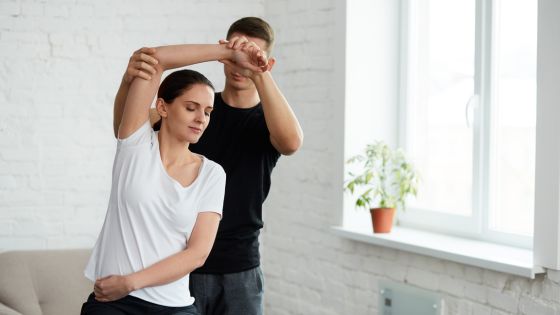Physical therapy, often woven into the path of recovery, rehabilitation, and enhancing movement, casts a net of diverse methods aimed at alleviating pain and improving function. While traditionally executed within clinical environments, there’s a budding focus on the applicability of physical therapy techniques within the cozy confines of our homes. Engaging in physical therapy at home not only propels consistent practice but also ensures that therapeutic exercises are seamlessly integrated into daily living. However, a crucial note to all readers: always consult with a professional physical therapist before embarking on DIY methods to ensure safety and efficacy.


Physical therapy is a healthcare domain that emphasizes restoring and maintaining functional mobility, minimizing pain, and preventing disability, typically through exercises, manual therapy, and adaptive strategies.
Physical therapy carves pathways to recover from injuries, manage chronic conditions, and enhance the body’s capability to perform daily activities effortlessly.
Incorporating physical therapy at home aims to amplify and consolidate the gains from professional sessions, ensuring sustained progress and continual rehabilitation.
A gentle reminder that integrating physical therapy practices at home should be executed under professional guidance to navigate the nuances safely and effectively.
Importance of Incorporating Physical Therapy at Home
Home, a space denoting comfort and ease, allows individuals to engage in therapeutic exercises without the hassle of travel, providing a familiar and relaxed environment to foster consistent practice.
Incorporating physical therapy into the home routine ensures that therapeutic interventions are not sporadic but rather woven into the daily fabric, propelling continuous and sustainable progress.
Complementing professional sessions with home exercises augments the benefits attained during clinic visits, ensuring that every stretch and strengthening move finds a deeper integration into the functional repertoire.
Navigating through the journey of physical therapy, both within clinical environments and at home, unravels a pathway where every movement becomes a therapeutic intervention, every exercise a step towards enhanced functionality. Let’s delve deeper into establishing a potent, safe, and empowering home therapy space in the subsequent sections.
Establishing a Safe and Effective Home Therapy Space
Choosing the right spot is paramount when setting up a home therapy space. Ideally, opt for an area with ample room to move freely, ensuring that your exercises can be performed without restrictions or risks of knocking into objects.
Safety comes first! Ensure that the chosen space is free from potential hazards, such as loose rugs or wet floors, and that all necessary items are within arm’s reach to prevent unnecessary bending or stretching during sessions.
Equip your space with basic therapy tools such as resistance bands, a stability ball, and perhaps a yoga mat. Ensure that these tools are suitable for the exercises planned and are stored safely when not in use.
DIY Physical Therapy Exercises
We can broadly categorize physical therapy exercises into strengthening, flexibility, and balance activities. Each category plays a crucial role in enhancing your physical abilities and should be incorporated into your routine judiciously.
- Strengthening: Wall Push-Ups. Stand about an arm’s length from the wall, place your hands flat against it, and push forward and back, keeping your body straight.
- Flexibility: e.g., Shoulder Rolls. Gently roll your shoulders forward and backward in a smooth, circular motion.
- Balance: e.g., Heel-to-Toe Walk. Walk in a straight line, placing your toe directly against the heel with each step.
Different exercises target various muscle groups and aspects of mobility. For instance, while wall push-ups enhance upper body strength, heel-to-toe walks enhance balance and stability, catering to different needs in your physical therapy journey.
Navigating through the realms of home-based physical therapy encompasses creating a safe environment and curating exercises that resonate with your therapeutic needs. The subsequent sections will further explore how everyday activities can become therapeutic exercises and how technology can be a boon in managing and enhancing your home therapy sessions.
Utilizing Everyday Activities as Therapeutic Exercises
Leverage daily tasks such as sweeping, reaching for items, and climbing stairs as subtle yet effective physical exercises. These activities engage various muscle groups and can be employed to enhance functional mobility.
Therapeutic Benefits
- Sweeping: Engages the shoulder and arm muscles, providing a gentle workout and enhancing range of motion.
- Reaching: Extending your arm to get items from a shelf can assist in improving shoulder mobility and stability.
- Climbing Stairs: Strengthens lower extremity muscles and enhances cardiovascular endurance when done repetitively.
Guidelines for Safe Practice
Ensure safety by:
- Adapting movements to your current physical capabilities
- Utilizing support as needed, such as gripping onto sturdy objects
- Gradually incorporating these activities into your routine to prevent overexertion
Incorporating Technology into Home Physical Therapy
Harness the power of the internet to access a plethora of online platforms, offering guided exercise sessions and credible information pertinent to physical therapy.
Virtual platforms provide access to licensed physical therapists who can guide your home therapy sessions, ensuring that exercises are performed accurately and effectively.
Use mobile applications designed to track your exercise routines, monitor progress, and possibly provide feedback on improving techniques or advancing to the next level in your therapeutic exercises.
Tapping into the potential of everyday activities as part of your physical therapy regime and embracing technology ensures a holistic, integrated, and optimized approach towards healing and rehabilitation in the comfort of your home. Further sections will delve into monitoring your progress and the criticality of balancing DIY methods with professional guidance.
Monitoring Progress and Adjusting the Plan
Documenting your activities, pain levels, and any difficulties encountered during exercises provides tangible data to track progress and areas needing adjustment.
Recognizing and celebrating milestones, be it small increments in exercise duration or reduced pain levels, are essential to staying motivated and acknowledging progress.
Tailor your exercise routine by considering your progress. Incrementally intensify the activities or adapt them to ensure they remain beneficial and avoid causing discomfort or strain.
Embarking on a journey of home-based physical therapy amalgamates the professional expertise with your daily routines, fostering a consistent, accessible, and individualized approach towards rehabilitation and physical well-being. The careful crafting of a safe therapeutic space, thoughtfully integrating exercises into your day, and strategically employing technology transforms everyday moments into opportunities for healing and enhancement. The continuous tapestry of professional guidance ensures that this autonomous journey is not solitary but rather is subtly overseen, ensuring safe practices and aligned progression. Remember, each stretch, each movement brings you a step closer to enhanced mobility and a life less hindered by physical limitations. Here’s to moving freely, steadily, and wisely on your path to recovery and beyond. May your journey be empowered, enlightening, and ever-forward.


























